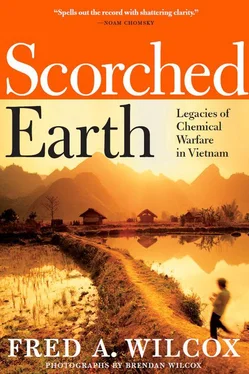Critics dismiss this approach to determining the cause of birth defects found in Vietnamese children as “anecdotal.” In one sense, as attorney Dean Kokkoris pointed out, they have a valid argument. Vietnamese researchers are not willing to feed human beings dioxin-laced rice. They have not injected dioxin into the bodies of perfectly healthy men and women. Scientists in other parts of the world refuse to treat human beings like lab rats. Until researchers give up their aversion to testing dioxin on human beings, the lawyers who work for the chemical companies and the judges who preside over Agent Orange lawsuits will refuse to accept the argument that dioxin harms human beings.

Showing off for visitors.
During our travels, we have seen children with missing fingers, toes, arms, and legs; children with lobster claw hands, twisted feet, large heads, stunted bodies, strange dark blotches on their faces and arms, purple bark-like skin. We’ve heard parents talk about children whose brains seem to develop normally for a few years and then, for some inexplicable reason, this growth stalls, freezing the child’s development at an early age, so that while he might resemble a quite ordinary Vietnamese adolescent, he can not perform simple tasks.
Like all of the Vietnamese doctors, scientists, and community workers with whom we meet, Dr. Tan is fully aware that some people refuse to believe that dioxin is responsible for the blind girl who spends her days banging her face against the slats of her crib; the boy whose watermelon head looks like it might explode; the teenage girl with missing arms who has learned to draw and write by holding a pencil between her toes; the small boy whose body stopped developing just below the waist, so he sits, half of him, huge brown eyes sad beyond sad; the little girl who scoots about the ward on chubby stumps that will never develop into legs.
“People come from all over the world to visit Tu Du’s Peace Village,” says Dr. Tan, “We ask them if they’ve ever seen any cases like the children in Vietnam that we are working with. And some of them say they have never seen a case like this. Others say yes, they have, but it is quite rare. These are doctors from around the world, Australia, Canada, France, and they see these children, and they know that they come from areas that were heavily sprayed with Agent Orange.
“I hope that when your book is published, the international community will then know what I, as a doctor, have seen all these years—that Agent Orange was used in Vietnam, causing problems for people here, not just for the first generation, but for other generations.”
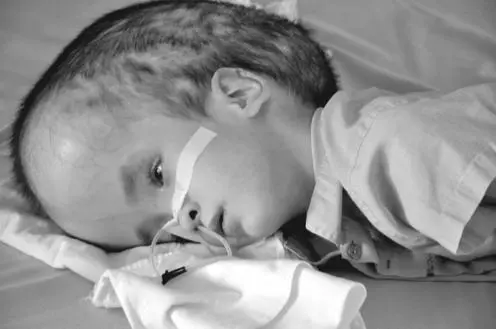
Boy with a large head.
“When Agent Orange was sprayed here,” Dr. Tan continues, “it left a burden until now, so we have so many children suffering from Agent Orange, and it is a burden for the economy and for society. And I want to say that the ones who sprayed the Agent Orange have to be responsible for what they did in Vietnam. They have to compensate, and they have to help us to solve this problem. This is their responsibility.”
In 1995, friends of Vietnam from the German city of Oberhausen established Peace Village at Tu Du Hospital, a place where Agent Orange children can live in a genuinely loving, supportive community. There are other peace villages in Ho Chi Minh City, Cu Chi, Danang, and Hanoi. In these villages, the staff gives the children love and treats them with kindness and dignity. Vietnam’s Agent Orange children suffer from a variety of physical handicaps and mental disabilities, but this does not keep them from greeting us with laughter and hugs. They pose for pictures, want to be picked up, and show off like ordinary children, except they must scramble about on missing, deformed, and stunted limbs.
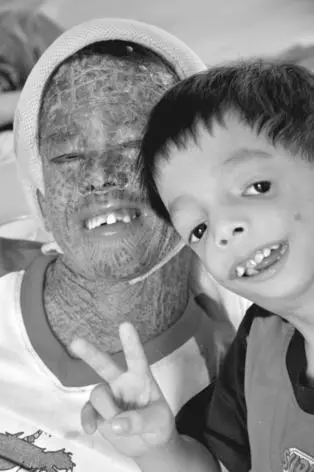
Pals
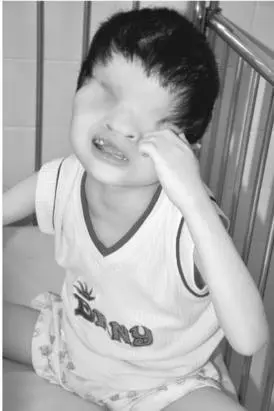
Girl born without eyes.
Duc enters the room in a wheelchair, and we talk briefly about the operation that separated him from Viet. He works as a computer technician at Peace Village and has been married for two years. Does he feel any anger toward the United States government or the chemical companies?
“No,” he says. “I don’t care about this. Because I know that if I get angry, nothing can change my life. I was born with such a situation, so what I’m doing now is to strive for my life. To try my best to have a good life.”
Like Dr. Tan, he wants the chemical companies to do something to help people. Most people live in rural areas, and they have a difficult life, he says. So there must be some kind of action taken to help them.
Duc and his wife plan to have their first child this year. He leaves before we get a chance to ask him what they plan to name their new baby.
Dr. Tan motions for us to follow her and we do so without hesitation, having learned that the Vietnamese never bother to explain where we might be going. Over the course of our trip, we’ve taken taxis to buildings where we’ve been told to appear at a given time of day. A man gets into the taxi, and we drive through the streets of Danang stopping to pick up other people, most often young women who are not unfriendly, but who never introduce themselves or explain why they are joining us. After a while, you get used to being driven here and there, getting out, getting back in. At first, following Dr. Tan through this hospital feels no different. But at the end of the hall, she opens the door to a room where the monsters are kept.
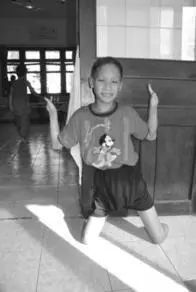
Boy missing hands and feet
As a young intern in Saigon’s Tu Du Hospital, Dr. Nguyen Thi Ngoc Phuong loved delivering babies to mothers. The year was 1963, and President Ngo Dinh Diem was mounting a reign of terror in the city and countryside. Buddhist monks were marching through the streets to protest Diem’s brutal attacks on them. In one such action, Thich Quang Duc sat down at a Saigon intersection and clasped his hands in prayer as a fellow monk doused him with gasoline, and another monk touched a lighter to his saffron robe. Duc sat upright, unmoving until his lifeless body collapsed into the street. A photograph of this burning monk appeared on the front page of newspapers throughout the world.
Asked how she felt about these protests, Madame Nhu, the “dragon lady” wife of Diem’s brother, called the self-immolations “barbecues,” and vowed to clap whenever monks died that way.
Dr. Phuong continued working in the hospital’s maternity ward, bringing red-faced, wrinkled, crying babies into the world. To Dr. Phuong, this was the natural cycle of life: Mothers give birth to babies; babies grow up, get married, and have families of their own; people grow old and die.
“I didn’t know anything about the spraying,” says Dr. Phuong, “And nothing about Agent Orange. But one day—it was 1969—I delivered for the first time in my life a severely deformed baby. It had no head or arms. The mother didn’t see her child, and I tried to hide my tears and my fear from her. I couldn’t bring myself to tell her what the baby looked like, so I said it was very weak. It died, and I just told her that it had been too weak to live.”
Читать дальше
